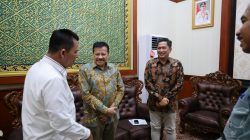Dr. H. Tirtayasa, S.Ag., M.A.
Graduate of the Thousand Ulama Doctor Cadre Program
Indonesian Ulema Council (MUI) and National Zakat Board (BAZNAS RI), Class of 2021
The history of money begins with the inefficiencies of barter systems in meeting increasingly complex economic needs. In early societies, humans exchanged goods and services directly based on mutual needs. However, barter was limited by what economists call the “double coincidence of wants”—the difficulty of finding a party who both possesses what one needs and simultaneously desires what one owns (Sultanum, 2024).
To resolve this, communities began to adopt items with mutually agreed value as mediums of exchange. In West Africa, cowrie shells served this purpose; in ancient Rome, salt was used as payment. In early Chinese societies, metal objects in the shape of tools or knives represented early prototypes of money. Thus, from the outset, money was fundamentally a social agreement, not a purely intrinsic commodity (Kitamura, 2022).
The Emergence of Coinage
The introduction of coinage marked a major shift in monetary systems. Around the 7th century BCE, the kingdom of Lydia (modern-day Turkey) minted the first known standardized coins from electrum, a naturally occurring gold-silver alloy. These coins bore official symbols guaranteeing their weight and value, fostering trust in trade (Wikipedia, 2025a).
Coinage also introduced a political dimension. Islamic dirhams and dinars, for instance, bore Quranic inscriptions affirming the legitimacy of the caliphate. Roman coins commonly featured the emperor’s image, functioning as instruments of ideological reinforcement. In both cases, money extended beyond its economic role to symbolize authority and identity (Cambridge, 2025).
The Evolution Toward Paper Currency
Paper money first emerged in China during the Song Dynasty in the 11th century. The rapid expansion of trade made carrying large quantities of metal cumbersome. Promissory notes—initially exchangeable for gold or silver—offered a practical alternative (Wikipedia, 2025b).
At first, paper notes represented claims on physical reserves, known as representative money. However, over time, confidence in the issuer—typically the state—became more critical than metal backing. Europe saw a similar evolution, where deposit receipts and government bonds gradually transformed into circulating paper currency.
This shift laid the groundwork for modern monetary systems based on fiat money, where currency’s value is no longer tied to a physical commodity.
The Age of Fiat Currency
Fiat currency, unlike commodity-backed money, holds value solely through legal decree and public confidence. This system gained dominance in the 20th century, particularly after the United States officially abandoned the gold standard in 1971.
Chartalist theory asserts that money derives its value from state authority. It becomes money not because of its substance but because the state mandates its use—particularly for paying taxes (Knapp, 1905; Sultanum, 2024). This view, later developed by Keynes and post-Keynesian economists, remains central to modern monetary theory (Richmond Fed, 2024).
While fiat money allows governments greater flexibility in managing economies, it also introduces risks such as inflation, currency devaluation, and loss of public trust.
Local Currency in Historical Indonesia
Indonesia’s monetary history demonstrates localized adaptation to global changes. Before colonial rule, various ethnic groups used diverse items such as beads, cowries, and bronze discs as currencies. Each region had its own standard, reflecting local values and exchange practices (PijarBelajar, 2023).
The Dutch East India Company (VOC) introduced foreign coins, including Spanish silver dollars and Dutch stuivers. De Javasche Bank began issuing banknotes in the 19th century, which circulated widely across the archipelago (Wikipedia, 2025c).
Following independence, the Republic of Indonesia introduced the Oeang Republik Indonesia (ORI) in 1945 as a symbol of sovereignty. However, the national currency, the rupiah, underwent several reforms due to hyperinflation, exchange rate instability, and political transitions. This evolution underscores that money is a dynamic institution constantly redefined by social and political forces.
Economic Theories on the Role of Money
Classical economists such as Adam Smith viewed money primarily as a lubricant for trade. Marginalist economists like Jevons emphasized money’s functions as a unit of account, a store of value, and a medium of exchange (Kitamura, 2022).
In the 20th century, microeconomic models such as the overlapping generations (OLG) model and the Lagos-Wright framework explained money as a coordination device that enhances economic efficiency in the absence of perfect information or barter systems (Sultanum, 2024).
Historical evidence also shows that societies learn from past experiences. Through trial and error, they reform payment systems, replace monetary instruments, and adapt institutions to meet evolving needs (Annual Reviews, 2023).
Dematerialization and Electronic Money
Technological developments have profoundly transformed the form and function of money. Debit cards, mobile wallets, and real-time fund transfers have led to the dematerialization of money. Today, money is increasingly experienced as digital data rather than physical notes and coins (Kitamura, 2022).
This shift enhances efficiency but also introduces new vulnerabilities: cybersecurity risks, digital inequality, and over-reliance on financial infrastructures (Financial Times, 2024).
Cryptocurrencies like Bitcoin challenge conventional notions of money by eliminating central authorities. Although not yet replacing state currencies, these decentralized digital assets have sparked global debates on the nature and future of money (Arxiv, 2015).
The Rise of Central Bank Digital Currencies (CBDCs)
Central banks worldwide are experimenting with Central Bank Digital Currencies (CBDCs) as official digital legal tender. CBDCs aim to combine the trustworthiness of fiat money with the technological advantages of digital transactions.
Proponents argue that CBDCs can promote financial inclusion, reduce transaction costs, and enhance monetary sovereignty. However, challenges remain—particularly regarding data privacy, the risk of disintermediation in traditional banking, and regulatory oversight (Annual Reviews, 2023).
CBDCs represent a significant development in monetary history, one that could redefine the architecture of future financial systems.
Political Symbolism in Monetary Design
Beyond its economic functions, money serves as a medium of political expression. The portraits, languages, and historical narratives on banknotes and coins convey ideological messages.
In many countries, monetary redesign has accompanied political transitions. In Indonesia, changes in currency design mirrored the shifts from the Old Order to the New Order and subsequently to the Reform era. These shifts demonstrate money’s role in shaping national identity and collective memory (Cambridge, 2025).
Money as Social Technology
Money is often described as a form of “social technology” that enables large-scale cooperation. Like fire for early humans, money revolutionized how societies organize themselves, distribute resources, and build institutions (Financial Times, 2024).
Archaeological findings, such as the Ishango Bone dated to 18,000 BCE, suggest that record-keeping systems related to debts and obligations predate formal currencies. This indicates that money is not just a medium of exchange but a cultural and cognitive tool (The Times, 2024).
Conclusion: Learning from History, Preparing for the Future
The history of money is, fundamentally, a history of trust. From barter to blockchain, humanity has continually devised new ways to measure, store, and transfer value. Despite changes in form, the underlying principle remains: money derives its power from collective belief.
Today, we stand at the threshold of a new monetary era—characterized by digital currencies, artificial intelligence in financial markets, and algorithmic governance. Understanding the past equips us to navigate this future wisely.
Money is more than an economic artifact; it is a mirror reflecting how we organize, remember, and trust one another.
References
- Annual Reviews. (2023). Understanding Money Using Historical Evidence. Annual Review of Economics. https://www.annualreviews.org/content/journals/10.1146/annurev-economics-091923-040328
- Arxiv. (2015). Bitcoin and Cryptocurrency Technologies. https://arxiv.org/abs/1508.04364
- Cambridge. (2025). Reading the History of Money Politically or Ideologically. Modern Intellectual History. https://www.cambridge.org/core/journals/modern-intellectual-history/article/reading-the-history-of-money-politically-or-ideologically/FC2AA72F5D3AFDCD701BBD934DDA8F04
- Financial Times. (2024). Money: A Story of Humanity. https://www.ft.com/content/7366c887-688f-4022-83e7-8d095a7c75ea
- Knapp, G. F. (1905). The State Theory of Money. London: Macmillan.
- Kitamura, Y. (2022). Overview of the History of Money. In Quest for Good Money. Singapore: Springer.
- OCBC. (2021). The History of Money: Origins, Types, and Functions. Jakarta: OCBC NISP. https://www.ocbc.id/id/article/2021/09/16/sejarah-uang
- PijarBelajar. (2023). The History of Money in Indonesia and the World. Jakarta: Pijar. https://www.pijarbelajar.id/blog/sejarah-uang-di-indonesia-dan-dunia
- Richmond Fed. (2024). Essentiality of Money: A Historical Perspective. Economic Brief No. 24-01. https://www.richmondfed.org/publications/research/economic_brief/2024/eb_24-01
- ScienceDirect. (2025). Monetary History – An Overview. Amsterdam: Elsevier. https://www.sciencedirect.com/topics/economics-econometrics-and-finance/monetary-history
- Sultanum, B. (2024). The Role of Money in Economic Coordination. Washington, DC: Federal Reserve Bank.
- The Times. (2024). Was Money Man’s Most Significant Creation? London: The Times. https://www.thetimes.co.uk/article/was-money-mans-most-significant-creation-times-luxury-xr5thxpxp
- Wikipedia. (2025a). Money. https://en.wikipedia.org/wiki/Money
- Wikipedia. (2025b). Fiat Money. https://en.wikipedia.org/wiki/Fiat_money
- Wikipedia. (2025c). History of the Indonesian Rupiah. https://en.wikipedia.org/wiki/History_of_the_Indonesian_rupiah








